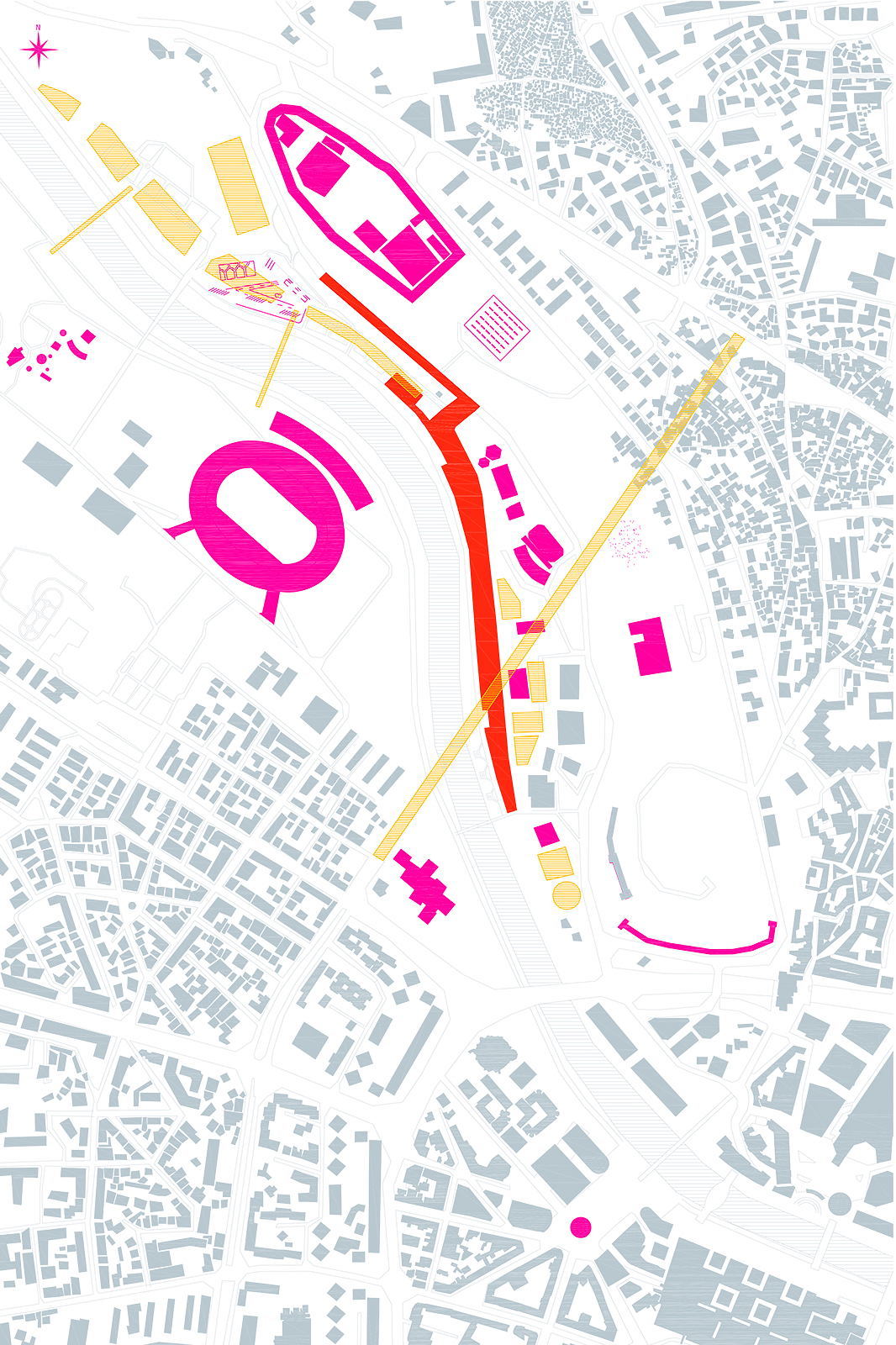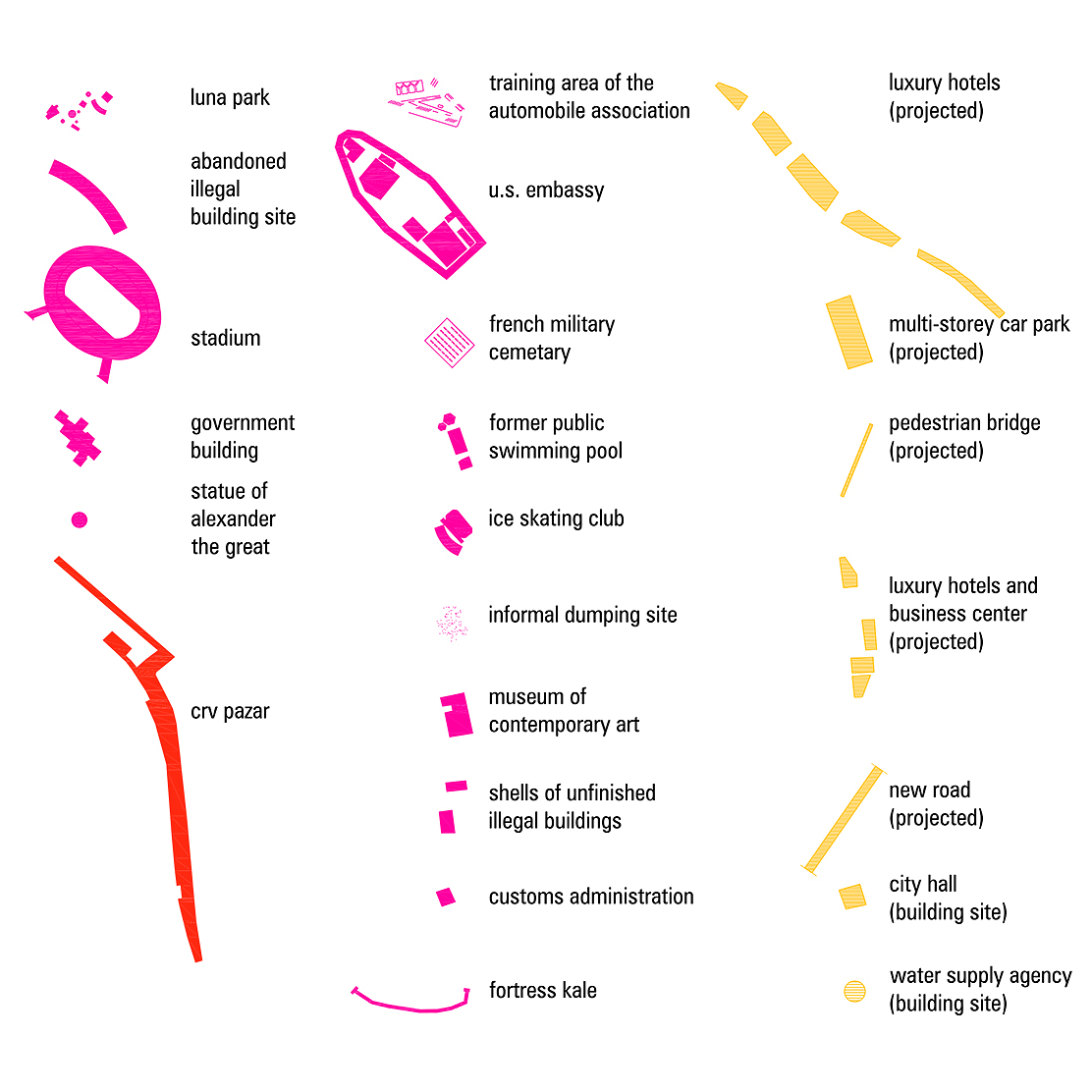Crv Pazar – Skopje
In Skopje there is a saying that “in the Crv Pazar, ‘nema sto nema’” – which means “there is nothing you can think of that you will not find in Crv market”. Goods for sale range from used computers to fashionable high heels, new bicycle tires, fresh vegetables, industrial potato peelers, antique furniture and live worms – usually at prices less than 50 percent of what they would be elsewhere.
The worms, which gave the market its name and all of the other goods are sold from the trunk of cars, on shaky folding tables or directly on the dusty, sometimes muddy ground. Between these improvised stands mobile vendors offer grilled meat and cool drinks from their pushcarts.




Crv Pazar is situated below the fortress hill Kale, only 500 meters distant from the new enormous bronze-statue of Alexander the Great on the central square Plostad Makedonija. The market stretches out for approximately one kilometer along the northern bank of the river Vardar, which crosses the city, forming a geographical and historical dividing line. On the northern side of the river, the old historic center of Skopje with its Ottoman bazaar and the surrounding quarters are mainly inhabited by members of the large Albanian minority and the Roma population. The parts of the city south of the river were constructed more recently, in the late 19th and 20th centuries, and are inhabited primarily by Macedonians. This cultural segregation has been longstanding, and was already regarded as problematic in 1963, when a devastating earthquake struck Skopje, destroying seventy percent of the city. Following the disaster, a major international reconstruction effort involving the assistance of both Eastern block and Western countries under UN supervision was seen as an opportunity to address these cultural divisions. Under the new plan, the whole structure of the city would be rationalized and a totally new city center created. This city center was to become the essence of the “Open City of Skopje”, open to a society in flux.
The Japanese architect Kenzo Tange won the competition for the master plan of the city center. The core element of his plan was the “nucleus”, a distinct zone along the riverbanks enhanced with numerous public functions intended to turn the boundary of the river into a space of collectivity and openness for every citizen of Skopje. These plans were to include a recreational green space in the area adjacent to Kale, the location of today´s Crv Pazar1. However, the plan was often modified and only partially realized. In the decades since reconstruction, Tange’s nucleus never became the intended unifying core but rather an urban void. For decades it has been a buffer zone in the divided city, no one´s and everyone´s non-place. In this terrain vague many completely independent and unrelated functions have developed next to each other – without actually interfering with each other. Today in the immediate neighborhood of Crv Pazar, one finds a training area of the automobile association, the giant American embassy built in 2009, a French military cemetery, an informal dumping site, a former public swimming pool now modified into a striptease establishment, the Museum of Contemporary Art, the shell of an unfinished illegal building, the Customs Administration and the original fortifications of Kale itself. On the opposite side of the river, the market faces the representative government building, the newly renovated stadium, another abandoned illegal building site and a run-down luna park.

Tange´s “nucleus” has turned into a space where anything seems possible. It´s no coincidence that this buffer zone was chosen as the site for the gigantic restructuring project “Skopje 2014” that was presented by the populist conservative government in 2010. Almost twenty years after the dissolution of Yugoslavia, this project is reinventing and reaffirmating Macedonia´s seperable, undeniable and glorified national identity through urbanism and architecture. A very large number of new public buildings (most of them designed in a neo-classical style), religious symbols and memorials more or less exclusively celebrating Macedonian culture are proliferating in what was originally meant to be the core of the “Open City” and was until recently everyone´s non-place.2
At present, Skopje´s city center resembles one big construction site, extending to the south-eastern end of the Crv Pazar, where the new city hall and the building for the municipal utilities are under construction. These developments put a definite end to the constant growth of the market in recent years. Some decades ago, Crv Pazar started out as an assembly of a few stands selling equipment for fishermen such as handmade or live baits. Originally situated in the southern quarter of Mlin Balkan, the market later moved in front of the fishermen´s association in the eastern quarter of Jugo Drvo and finally in the late 1980s to its current position below the hill Kale. The rapid growth of the market in the recent years and the accompanying change in the goods offered has been caused by two circumstances.
First, the unemployment rate in Macedonia is constantly high and currently lies at 29.9 percent3 which favors alternative economies and low price levels. Second, various building projects have displaced informal markets in other areas of the city. For example, some informal parts of the central Bit Pazar had to give way to investor projects. In the south, the construction of a shopping center and hotels took the place of the vegetable wholesalers from all over Macedonia on Juzhen Bulevar. Integrating the displaced and the new sellers the range of goods on Crv Pazar extended from fishermen´s equipment to vegetable and fruits as well as used goods. The second name of the market “Kanta Pazar” pays tribute to its new character: goods on the market traverse a complete cycle from the apartment to the cellar to the waste container (“kanta”) to the market and back to the apartment…
Crv Pazar has become an important trading place especially amongst unemployed and retired (at the worst making a living from around 100 Euro pension a month) from all ethnic groups. Due to its central position in the city the market is easy to reach by foot or bicycle from Albanian and Macedonian as well as Roma neighborhoods.4 From the northern river bank, Crv Pazar can be reached via Lazar Lichenoski Street linking two of the main boulevards at the foot of the hill Kale and passing by the north-western end of the market. The connection to the southern river bank is established by a pedestrian bridge at the south-eastern end of the market.

The
growth of the market in recent years can also be read in its internal
organization. The sellers of fishermen´s equipment who first offered their
goods here, are positioned at the north-eastern end, close to Lazar Lichenoski
Street where a car park barrier restricts the access to the market area for
cars. From here the market stretches out to the south-east with the sellers of
new and used goods, some specialized, some mixed. The vegetable wholesalers are
positioned outside of the limited area on the street. Sellers entering the
market area by car have to pay a 50 Denar fee (0.80 Euro) to the automobile
association at the barrier. Next to the barrier the only permanent architecture
of the market can be found: two wooden barracks rented from the automobile
association and used as magazines by vegetable traders. The architecture of the
stands usually consists of a means of transport (a car, a bicycle, a trolley or
a pushcart), a presentation plane (the trunk or hood of a car, a folding table
or a plastic awning on the ground) and a sunshade. The stands in the market
area organize in two to four irregular rows that follow the layout of the paths
written in the sandy ground. The only infrastructure that can be found is a
damaged drinking fountain that runs constantly. There are no toilets or storage
facilities in the market area, so sellers occasionally leave their structures
at place or hide them in the bushes. Regular cleaning of the place is self-organised
amongst the sellers who collect money to pay someone who moves the waste and
goods not sold to a concrete wall along the market where it is burned –
occasionally followed by efforts of the fire service.
Crv Pazar is active year round, with a constant appearance of the vegetable wholesalers but less sellers of fishermen´s equipment in winter. The fishermen´s market traditionally operated on Friday and Saturday mornings to supply the customers for the weekend. With the integration of the new and used goods, Tuesday was established as an additional market day, while vegetables are sold daily. The market day starts at 4:00 (vegetables) 5:00 (new and used goods) and 6:00 (fishermen) and runs until 9:00 (vegetables), 13:00 (new and used goods) and the evening (fishermen).5 On days when the market doesn´t operate the area stays empty, serving as parking place for the nearby stadium or the open-air discos on the other side of the river. At night it is known as a location for intimate rendez-vous, as it is common for young Macedonians to live with their parents until marriage.
While Crv Pazar
operates well within its own internal system of spatial and temporal
organization, it has been regarded as problematic by the city administration
especially since its significant growth. In 2006, the administration announced
a decision to clear the area (officially designated as a “waste dump”), and
presented a proposal to transform the site into a recreational green space.
This resulted in a vigorous and organized reaction on the part of merchants
with protests in front of city hall. The plans were never implemented, possibly
due to the combined effects of popular dissent, political changes within the
administration, and a general shift in civic priorities. Since then, the
official posture towards the market has been one of discouragement rather than
outright prohibition, with periodic police inspections for stolen goods and
aggressive enforcement of parking regulations (for example, towing of parked
cars on Lazar Lichenoski Street). A more significant threat to Crv Pazar is the
ongoing transformation of the city center. Official plans suggest the
construction of a new road over the river Vardar, while the state owned land of
the market area is currently being privatized. A row of eight luxury hotels in
neo-classical and neo-baroque style and a parking garage are expected to be
erected along the river. Indeed, the ministry of transportation and
communication which is in charge of the privatization has already sold several plots
to private investors, which signifies the imminent end of Crv Pazar activities
in this location. With regard to the gigantic building projects in central
Skopje and the ongoing economic crises the market will have to find a new, more
marginal location.
Shortly after the finalization of our research on Crv Pazar, the market was cleared and locked up in an action of several days. In an official note the district administration announced that two diggers, five trucks and fifty workers cleaned an area of 10.000m² and disposed 200m³ of garbage. After several days of protest, the sellers reorganised and since then all market activities have been taking place along the adjacent Lazar Lichenoski Street.
1 cf. United Nations (ed.): Skopje Resurgent. The Story of a United Nations Special Fund Town Planning Project. New York 1970.
2 cf. Milan Mijalkovic, Katharina Urbanek: Skopje – The World´s Bastard. Architecture of the Divided City. Klagenfurt 2011.
3 www.stat.gov.mk [07.07.2013]
4 It is said that several Roma who fled the Kosovo are making their living by selling goods on Crv Pazar.
5 Interview with seller Stojan V. [03.07.2013


2014
With: Katharina Urbanek
Foto credits: Darko Hristov
Published in: Mooshammer, Helge / Mörtenböck, Peter
(Hg.): Informal Market Worlds Atlas. NAi Publishers, Rotterdam 2015. S. 236-241.
© 2025 Milan Mijalkovic. All rights reserved.